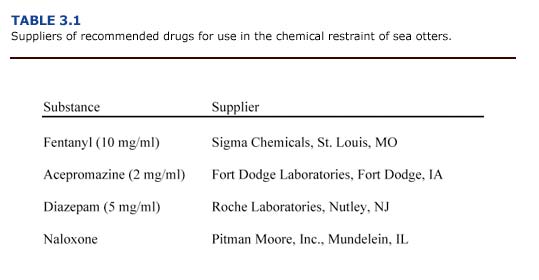Chemical restraint is recommended for the following procedures: 1) cleaning oiled sea otters, 2) administration of solutions via stomach tube, and 3) treatments requiring 2-3 hours of immobilization.
The preferred drug combination for safe neuroleptanalgesia in adult sea otters is fentanyl (0.2 mg/kg), acepromazine (0.05 mg/kg), and diazepam (0.5 mg/kg) (Williams and Kocher, 1978; Williams et al., 1981). An intramuscular injection is given in the large muscle mass of the hind limbs while the otter is physically restrained. To reverse the anesthetic effects of fentanyl, naloxone (1 mg/kg) is administered intramuscularly. The type, dose, and time of all injections should be noted in the medical records of each otter (Appendix 2, Form G Download PDF). Suppliers of the recommended drugs are listed in Table 3.1.

Dissociative anesthetics such as ketamine are not recommended because they may affect the sea otter’s normal thermoregulatory response, and several deaths have been reported (Williams and Kocher, 1978). Inhalant anesthetics such as isoflurane are not recommended for heavily oiled sea otters because they may aggravate lung damage associated with the exposure to fresh crude oil (see Chapter 1).
If a sea otter has been heavily oiled or is otherwise unhealthy, its tolerance to chemical restraint is improved by pretreating the animal with normal saline (20 ml/kg SQ or IV), enrofloxacin (2.5 mg/kg bid 1M or PO) for mature animals or amoxicillin (12 mg/kg bid 1M) for immature otters, and vitamin B-complex (0.1 ml/kg SQ). Chemical restraint is not recommended for otters that are hypothermic, severely lethargic, or unconscious.
Diazepam is not recommended in combination with fentanyl and acepromazine when release of the otter is imminent, because the animal may be too sedated and lethargic to be left unattended. Minor seizures associated with the neuroleptanalgesia produced by fentanyl and acepromazine alone are not usually life threatening. If cyanosis is observed, gentle chest compression should be initiated to stimulate breathing.
Fentanyl is an opioid drug that can cause profound sedation or unconsciousness, bradycardia, respiratory depression, and death, if accidentally sprayed into the conjunctiva of the eye or injected into a person. Consequently, only qualified staff should be allowed to administer drugs used for chemical restraint. Protective glasses should be worn when handling fentanyl; naloxone should be available to reverse the depressant effects of fentanyl. A strict drug security system must be in effect to avoid potential abuse of controlled drugs by personnel working in or around a rehabilitation center.

